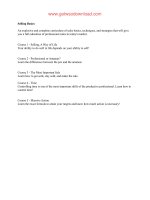4 1 how express works tủ tài liệu training pdf
Bạn đang xem bản rút gọn của tài liệu. Xem và tải ngay bản đầy đủ của tài liệu tại đây (68.82 KB, 14 trang )
Express
Framework
Starting with Express.js
Express.js is a web framework based on the core Node.js http module1 and Connect2 components. Those components are called
middleware. They are the cornerstone of the framework’s philosophy, which is configuration over convention. Some developers familiar
with Ruby compare Express.js to Sinatra, which has a very different approach from the Ruby on Rails framework that favors convention
over configuration. In other words, developers are free to pick whatever libraries they need for a particular project. This approach
provides them with flexibility and the capability to highly customize their projects. If you have written any serious apps using only the
core Node.js modules, you most likely found yourself reinventing the wheel by constantly writing the same code for similar tasks, such
as:
1.
2.
3.
4.
5.
6.
7.
Parsing HTTP request bodies
Parsing cookies
Managing sessions
Organizing routes with a chain of if conditions based on URL paths and HTTP methods of the requests
Determining proper response headers based on data types
Handling errors
Extracting URL parameter (e.g., /messages/3233)
Starting with Express.js
Later, you might have created your own libraries to reuse the code, but your
libraries would not be as thoroughly tested as the best community supported
libraries. Also, the maintenance would be fully on you and your team. So, my
recommendation is to use the community module if it suites your needs. This
advice applies to using small libraries and web frameworks as well. Express.js
solves these and many other problems. It provides ways to reuse code elegantly
and provides a model-view-controller (MVC)-like structure for your web apps. The
model (M) part needs to be supplied by an additional database-driver library (e.g.,
Mongoose3 ). Those apps could vary from barebones, back-end-only REST APIs
to full-blown, full-stack, real-time web apps with additional libraries such as
jade-browser ( and socket.io
().
To get you started with Express.js quickly and without diving too deep into its API,
we’ll cover these topics in this chapter:
●
●
●
How Express.js works
Express.js installation
Express.js Generator installation
How Express.js Works
Express.js is a node package manager (NPM or npm) module that is a dependency to your application. This means that every project
that is built with/on Express.js needs to have the framework’s source files in the local node_modules folder (not globally!). For this, you
install Express.js just like any other NPM module, with $ npm install, e.g., $ npm install Now, we can overview a typical
structure of an Express.js application. Let’s say your application is in a server.js file and you plan to start your application with $ node
server.js. In that case, you need to require and configure Express.js in the server.js file. This file usually contains statements to
accomplish the following:
●
●
●
●
●
●
●
Include third-party dependencies as well as your own modules such as controllers, utilities, helpers, and models
Instantiations of the Express.js object and others
Connect to databases such as MongoDB , Redis , or MySQL
Configure Express.js app settings such as the template engine and its files’ extensions
Define middleware such as error handlers, static files folder, cookies, and other parsers
Define routes and their request handlers
Start the app which will start the server on a particular host and port
Of course, if your application is big, you’ll have multiple files to configure your Express.js app, not just a single server.js or app.js file.
The reason for that is better code organization. For example, in one file you will configure sessions, in another authentication, in another
routes, and so forth.
How Express.js Works
Third-Party Dependencies
Defining third-party dependencies is straightforward:
var name = require('name');
The dependencies typically include the Express.js library itself, along with necessary middleware such as body-parser.
Another way to define multiple dependencies is to follow each definition with a comma:
var express = require('express'),
compression = require('compression'),
bodyParser = require('body-parser'),
mongo = require('mongoskin');
How Express.js Works
Instantiations
To use Express.js, you need to instantiate it. At the same time, it’s a good practice
to instantiate any other objects:
var app = express();
var db = mongo.db('mongodb://localhost:27017/integration_tests', {native_parser:
true});
How Express.js Works
Connecting to Databases
Statements to connect to databases don’t have to be in the beginning, as long as they are before step #7 “Starting the app”
(from the list earlier in this section)—except in cases in which we use a database as a session store. For example:
var session = require('express-session');
var RedisStore = require('connect-redis')(session);
app.use(session({ store: new RedisStore(options), secret: 'Pro Express.js rocks!' }));
Most of the database drivers, such as Mongoskin7 and Mongoose8 , support buffering of the queries; this way, if the server
is running before the connection has been established, the database queries will be buffered for later execution (when the
database connection is established).
How Express.js Works
Configuring Express.js App Settings
Simply put, configuring Express.js app settings consists of setting some values to string keys
with app.set(). Some of these keys are used by Express.js and augment its behavior, while
others are arbitrary. For example, if you are using the Jade template engine and *.jade files,
use 'view engine' to let Express.js know that it needs to looks for *.jade files: app.set('view
engine', 'jade'); You’ll find a lot more information about configuring settings in the following
chapters. Sometimes we want to store a custom value on the server object for future
reference. For example, we can assign port to a value from the environment variable PORT
or, if it’s undefined, to 3000 so that we can use the value across all source code:
app.set('port', process.env.PORT || 3000);
How Express.js Works
Defining Middleware
Middleware is a special function that allows for better code organization and
reuse. Some of the middleware is packaged as third-party (NPM) modules and
can be used right out of the box. Other times, we can write our own custom
middleware. In both cases the syntax is app.use(): app.use(bodyParser.json());
How Express.js Works
Defining Routes
Routes can be either good old web pages or REST API endpoints. In both cases
the syntax is similar: we use app.VERB(), where VERB() is an HTTP method such
as GET, POST, DELETE, PUT, OPTIONS, or PATCH. For example, we can
define home page (root) routes as app.get('/', renderHomePage);
How Express.js Works
Starting the App
Finally, after everything is configured, we can boot up the server with
server.listen(portNumber), where server is a core http server object created with
the app object: var server = http.createServer(app); var boot = function () {
server.listen(app.get('port'), function(){ console.info('Express server listening on
port ' + app.get('port')); }); }; var shutdown = function() { server.close(); };
How Express.js Works
If this file is included by another file (e.g., a test), we might want to export the server object instead of boot it up.
The way we perform a check is by using require.main === module; if it’s true, then this file wasn’t included by
anything else. The test will boot up the server by itself using the method boot() that we export. We also export
shutdown() and port:
if (require.main === module) {
boot();
} else {
console.info('Running app as a module');
exports.boot = boot;
exports.shutdown = shutdown;
exports.port = app.get('port'); }
How Express.js Works
When an Express.js app is running, it listens to requests. Each incoming request is
processed according to a defined chain of middleware and routes, starting from the top and
proceeding to the bottom. This aspect is important because it allows you to control the
execution flow. For example, we can have multiple functions handling each request, and
some of those functions will be in the middle (hence the name middleware):
1.
2.
3.
4.
Parse cookie information and go to the next step when done.
Parse parameters from the URL and go to the next step when done.
Get the information from the database based on the value of the parameter if the user
is authorized (cookie/session), and go to the next step if there is a match.
Display the data and end the response.









